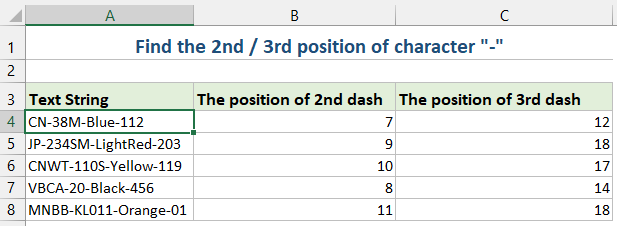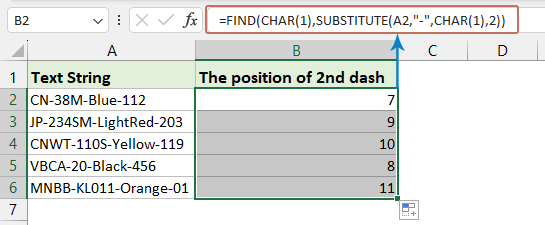Encontrar a ocorrência enésima de um caractere no Excel – 3 maneiras rápidas
Encontrar a ocorrência enésima de um caractere específico dentro de uma string de texto no Excel pode ser particularmente útil na análise de dados, onde você pode precisar analisar strings ou extrair informações com base em determinados delimitadores ou padrões. Por exemplo, vamos encontrar a 2ª ou 3ª ocorrência do caractere "-" em uma string de texto. Vou demonstrar técnicas diretas para realizar essa tarefa de forma eficiente.

Encontre a ocorrência enésima de um caractere em uma string de texto com fórmula
Você pode criar uma fórmula para encontrar a ocorrência enésima de um caractere. Por favor, faça o seguinte:
1. Insira ou copie a seguinte fórmula em uma célula onde deseja obter o resultado:
=FIND(CHAR(1),SUBSTITUTE(A2,"-",CHAR(1),2))- "A2": A célula que contém a string.
- "-": O caractere que você está procurando.
- "2": A segunda ocorrência que você deseja encontrar, você pode alterá-la para 3, 4… conforme necessário.
2. Em seguida, arraste a alça de preenchimento da fórmula para baixo para aplicar a fórmula a outras células, e a posição da segunda ocorrência do caractere "-" será exibida imediatamente, veja a captura de tela:
- "SUBSTITUIR" substitui a ocorrência enésima do caractere por um caractere não imprimível (CARACTERE(1)).
- "LOCALIZAR" procura esse caractere não imprimível, fornecendo a posição da ocorrência enésima.
Encontre a ocorrência enésima de um caractere em uma string de texto com Kutools para Excel
Se você não é fã de usar fórmulas ou VBA, pode considerar uma alternativa conveniente – "Kutools para Excel". Dentro dos seus grupos de Fórmulas, você encontrará um utilitário útil – "Localizar a posição da N-ésima ocorrência de um caractere em uma cadeia de caracteres", que identifica e retorna rapidamente a posição enésima de qualquer caractere em uma célula.
Após instalar Kutools para Excel, clique em "Kutools" > "Assistente de Fórmulas" > "Assistente de Fórmulas" para abrir a caixa de diálogo "Assistente de Fórmulas". Clique em uma célula onde deseja colocar o resultado. Em seguida, faça o seguinte:
- Selecione "Procurar" na lista suspensa da seção "Tipo de Fórmula";
- Escolha "Localizar a posição da N-ésima ocorrência de um caractere em uma cadeia de caracteres" na seção "Selecione uma fórmula";
- Selecione a célula que contém a string que você usa, depois digite o caractere especificado e a ocorrência enésima nos campos de texto na seção "Entrada de Argumento";
- Por fim, clique no botão "OK" para obter o resultado.

Kutools para Excel - Potencialize o Excel com mais de 300 ferramentas essenciais. Aproveite recursos de IA permanentemente gratuitos! Obtenha Agora
Encontre a ocorrência enésima de um caractere em uma string de texto com Função Definida pelo Usuário
Nesta seção, exploraremos como criar e usar uma UDF para encontrar a ocorrência enésima de um caractere no Excel, fornecendo um guia passo a passo para ajudá-lo a otimizar o manuseio de dados.
- Pressione as teclas "ALT" + "F11" e abrirá a janela "Microsoft Visual Basic for Applications".
- Clique em "Inserir" > "Módulo" e cole a seguinte macro na Janela do Módulo.
Function FindN(sFindWhat As String, _ sInputString As String, N As Integer) As Integer 'Updateby Extendoffice Dim J As Integer Application.Volatile FindN = 0 For J = 1 To N FindN = InStr(FindN + 1, sInputString, sFindWhat) If FindN = 0 Then Exit For Next End Function - Depois, feche a janela vba. Volte para a planilha, insira a seguinte fórmula em uma célula e arraste a alça de preenchimento para baixo para aplicar a fórmula a outras células, veja a captura de tela:
=FindN("-",A2,3)
- Conte o número de ocorrências de uma palavra em uma coluna
- Se você tem uma coluna de dados que inclui alguns valores duplicados, como mostrado na captura de tela abaixo, e agora o que você quer fazer é contar o número de ocorrências de uma palavra específica nesta coluna. Agora, com este tutorial, apresentarei alguns truques para resolver isso rapidamente no Excel.
- Substituir os primeiros n caracteres ou a ocorrência enésima de um caractere por outro
- No Excel, geralmente encontramos e substituímos uma string pela função Localizar e Substituir, mas se você estiver em um dos casos abaixo, a função Localizar e Substituir não poderá ajudá-lo.
- Extrair um caractere enésimo de uma string
- Em geral, você pode querer extrair a string após um caractere específico, mas neste caso, quero extrair o caractere enésimo de uma string, como mostrado na captura de tela abaixo.
- Extrair os primeiros/últimos n caracteres de uma string
- Por exemplo, há uma lista com strings longas em cada célula, e você quer extrair apenas os primeiros n caracteres de cada string, como os primeiros 3 caracteres de cada string, e agora você pode usar os seguintes métodos para resolvê-lo no Excel.
Artigos Relacionados:
Melhores Ferramentas de Produtividade para Office
Impulsione suas habilidades no Excel com Kutools para Excel e experimente uma eficiência incomparável. Kutools para Excel oferece mais de300 recursos avançados para aumentar a produtividade e economizar tempo. Clique aqui para acessar o recurso que você mais precisa...
Office Tab traz interface com abas para o Office e facilita muito seu trabalho
- Habilite edição e leitura por abas no Word, Excel, PowerPoint, Publisher, Access, Visio e Project.
- Abra e crie múltiplos documentos em novas abas de uma mesma janela, em vez de em novas janelas.
- Aumente sua produtividade em50% e economize centenas de cliques todos os dias!
Todos os complementos Kutools. Um instalador
O pacote Kutools for Office reúne complementos para Excel, Word, Outlook & PowerPoint, além do Office Tab Pro, sendo ideal para equipes que trabalham em vários aplicativos do Office.
- Pacote tudo-em-um — complementos para Excel, Word, Outlook & PowerPoint + Office Tab Pro
- Um instalador, uma licença — configuração em minutos (pronto para MSI)
- Trabalhe melhor em conjunto — produtividade otimizada entre os aplicativos do Office
- Avaliação completa por30 dias — sem registro e sem cartão de crédito
- Melhor custo-benefício — economize comparado à compra individual de add-ins

